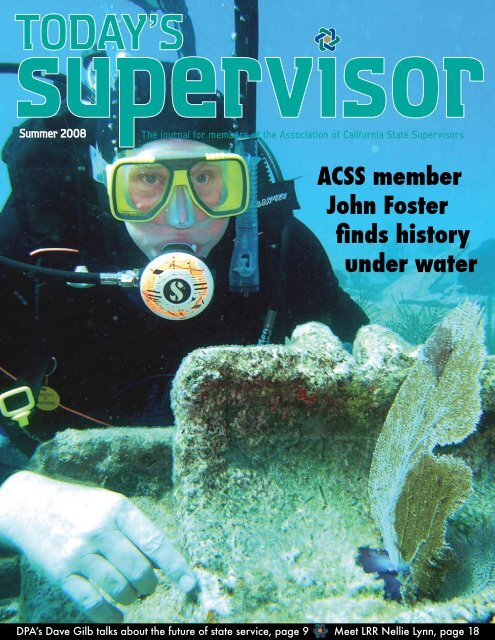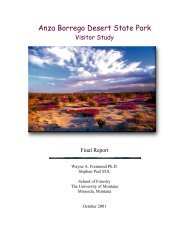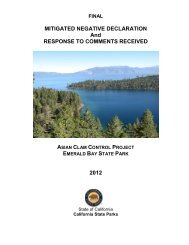Today's Supervisor 2008 Magazine Featured Article on John Foster
Today's Supervisor 2008 Magazine Featured Article on John Foster
Today's Supervisor 2008 Magazine Featured Article on John Foster
Create successful ePaper yourself
Turn your PDF publications into a flip-book with our unique Google optimized e-Paper software.
Summer <str<strong>on</strong>g>2008</str<strong>on</strong>g><br />
ACSS member<br />
<strong>John</strong> <strong>Foster</strong><br />
finds history<br />
under water<br />
Summer <str<strong>on</strong>g>2008</str<strong>on</strong>g><br />
DPA’s Dave Gilb talks about the future of state service, page 9 Meet LRR Nellie Lynn, page 18
Today’s <str<strong>on</strong>g>Supervisor</str<strong>on</strong>g><br />
Summer <str<strong>on</strong>g>2008</str<strong>on</strong>g><br />
Published since December 1987<br />
The journal of the<br />
Associati<strong>on</strong> of California<br />
State <str<strong>on</strong>g>Supervisor</str<strong>on</strong>g>s<br />
1108 O Street, Suite 317<br />
Sacramento, California 95814<br />
(800) 624-2137 • Fax: (916) 326-4364<br />
www.ACSS<strong>on</strong>line.org<br />
Mitchell C. Semer<br />
B<strong>on</strong>nie Morris<br />
Linda Holderness<br />
Diane Wolff<br />
Kathy Sullivan<br />
Tom C<strong>on</strong>sidine<br />
Kay DeGeest-Kelly<br />
Jerry Fields<br />
Jim Franco<br />
Paul Huggins<br />
Nellie Lynn<br />
Tim Behrens (509)<br />
Olin King (511)<br />
Frank Ruffino (513)<br />
Jerry Fountain (509)<br />
Carl Herth (514)<br />
Louis Espinoza (503)<br />
Arlene Espinoza (503)<br />
Elnora Fretwell (503)<br />
Louis Flores (504)<br />
Terry Sutherland (505)<br />
Chapter 502<br />
Chapter 503<br />
Chapter 504<br />
Chapter 505<br />
Chapter 507<br />
Chapter 508<br />
Chapter 509<br />
Chapter 511<br />
Chapter 512<br />
Chapter 513<br />
Chapter 514<br />
ACSS Staff<br />
Executive Board<br />
Directors<br />
Chapter Presidents<br />
Executive Officer<br />
Senior Labor Relati<strong>on</strong>s<br />
Editor<br />
Membership Coordinator<br />
Secretary<br />
Labor Relati<strong>on</strong>s Rep<br />
Labor Relati<strong>on</strong>s Rep<br />
Labor Relati<strong>on</strong>s Rep<br />
Labor Relati<strong>on</strong>s Rep<br />
Labor Relati<strong>on</strong>s Rep<br />
Labor Relati<strong>on</strong>s Rep<br />
President<br />
Vice President<br />
Director at Large<br />
Alt. Director at Large<br />
Secretary/Treasurer<br />
Evelyn Poppa-McKenna (507)<br />
Thomas Moy (508)<br />
Norman St<strong>on</strong>e (512)<br />
Elena Yuasa (513)<br />
Todd D/Braunstein (514)<br />
Vacant<br />
Fred Cherniack<br />
(916) 322-7423<br />
Radu Mischiu<br />
(707) 451-0182<br />
Martin Ly<strong>on</strong>s<br />
(415) 703-1643<br />
Reynold Roth<br />
(408) 363-7825<br />
Jessie Orosco<br />
(209) 669-2977<br />
Isidro “Sid” Ramirez<br />
(559) 576-6864<br />
Dolores Ramos Weeks<br />
(213) 576-6864<br />
Tami Fiscus<br />
(805) 547-7978<br />
Arlene Ryan<br />
(619) 525-4228<br />
Raquel Rios<br />
(562) 406-3945<br />
In this issue<br />
Where are the<br />
Baby Boomers<br />
now? Retiring. In five<br />
years, the state could<br />
lose 75 percent of<br />
its top management<br />
to retirement. DPA’s<br />
Dave Gilb talks about<br />
some changes we can<br />
expect, beginning <strong>on</strong><br />
page 9.<br />
From the editor’s desk<br />
A new day 2<br />
President’s message<br />
Catch the training 3<br />
ACSS news: A meet-and-c<strong>on</strong>fer 4<br />
ACSS people: Gold-medal hero 7<br />
Special Feature:<br />
The next generati<strong>on</strong> 9<br />
ACSS member:<br />
Sunken treasures 12<br />
ACSS training: Love your job 14<br />
It’s the LAW: Medicinal marijuana 16<br />
Meet your LRR: Nellie Lynn 18<br />
Photo: Charles Beeker, Indiana University<br />
On the cover<br />
All in a day’s work:<br />
State Archaeologist<br />
and ACSS member<br />
<strong>John</strong> <strong>Foster</strong> examines<br />
shipwrecks and other<br />
artifacts buried under<br />
California’s waters.<br />
Read about his unusual<br />
job <strong>on</strong> page 12.<br />
Summer <str<strong>on</strong>g>2008</str<strong>on</strong>g>
From the editor’s desk<br />
A new day<br />
Welcome to your new “Today’s <str<strong>on</strong>g>Supervisor</str<strong>on</strong>g>.” Let us<br />
know how we can serve you. From Linda Holderness<br />
After more than a year, ACSS is<br />
publishing “Today’s <str<strong>on</strong>g>Supervisor</str<strong>on</strong>g>”<br />
magazine again. For the near<br />
future, you can expect a new issue each<br />
quarter.<br />
Our primary goal, as it has always<br />
been, is to provide you with the informati<strong>on</strong><br />
you want and need as a state manager or<br />
supervisor. We will keep you informed of<br />
our efforts <strong>on</strong> your behalf with the Legislature<br />
and the governor, of state issues<br />
that c<strong>on</strong>cern you and of events you might<br />
benefit from attending or knowing about.<br />
We are going down a few new roads,<br />
too, spotlighting members and adding<br />
features that can make doing your job<br />
easier or even more fun.<br />
This m<strong>on</strong>th, we have something of<br />
everything.<br />
Even if you’re not a math pers<strong>on</strong>, you’ll<br />
grasp the numbers DPA Director Dave<br />
Gilb presented at the April board meeting:<br />
Nearly half of the state’s supervisory<br />
staff could retire in the next five years.<br />
Filling those positi<strong>on</strong>s with qualified<br />
workers will mean changing the way the<br />
state recruits and hires. We think you’ll<br />
find Dave’s visi<strong>on</strong> as compelling as we did.<br />
See the story <strong>on</strong> page 9.<br />
Have you heard a rumor that state jobs<br />
are boring? Meet <strong>John</strong> <strong>Foster</strong>. This ACSS<br />
member is not <strong>on</strong>ly California’s state<br />
archaeologist – he’s also the state’s sole<br />
underwater archaeologist. And if you’re<br />
w<strong>on</strong>dering, as I was, why the state employs<br />
an archaeologist who dives, you’ll be<br />
intrigued by his story, <strong>on</strong> page 12.<br />
I’m not sure I’d ever met a real hero<br />
until I interviewed DMV supervisor<br />
Nate Williams. Nate risked his life last<br />
year to save a young man from a burning<br />
car. The medal he received from Gov.<br />
Schwarzenegger was well-deserved. Nate’s<br />
story, <strong>on</strong> page 7, will warm your heart.<br />
Labor Relati<strong>on</strong>s Rep Nellie Lynn may<br />
not be quite a hero, but many of her clients<br />
could think of her as a savior. After<br />
19 years with CSEA and ACSS, Nellie<br />
is still committed to helping members resolve<br />
their c<strong>on</strong>cerns. Meet her <strong>on</strong> page 18.<br />
Also not to be missed: attorney Rocco<br />
Paternoster’s discussi<strong>on</strong> of how to deal<br />
medicinal marijuana in your workplace<br />
and a column of surprisingly useful<br />
remedies for making your work life more<br />
satisfying.<br />
But d<strong>on</strong>’t you do all the reading. We<br />
want to read, too – your letters and<br />
emails telling us what you think and what<br />
you’d like to see in future issues.<br />
Share with us your ideas. Introduce<br />
us to people we should spotlight. Let us<br />
know how we can improve.<br />
We’re your magazine.<br />
Summer <str<strong>on</strong>g>2008</str<strong>on</strong>g>
Sunken<br />
treasures<br />
There are no ‘pieces of<br />
eight’ at the bottom of<br />
the Sacramento River — or<br />
are there? ACSS member<br />
<strong>John</strong> <strong>Foster</strong> hunts the<br />
riches that lie buried in<br />
California’s waters<br />
Oh, the tales the Sacramento<br />
River could tell. Native<br />
Americans thrived <strong>on</strong> it,<br />
steamships plied it, gold<br />
seekers chased their dreams across it.<br />
Today’s river seems ordinary by comparis<strong>on</strong>.<br />
But still waters run deep.<br />
Hidden beneath this river, and other<br />
California waters, are troves of historic<br />
treasures. State Archaeologist and ACSS<br />
member <strong>John</strong> <strong>Foster</strong> finds these artifacts<br />
and coaxes out their history. He unearths<br />
not the b<strong>on</strong>es of animals but the b<strong>on</strong>es of<br />
our culture and helps us understand them.<br />
<strong>Foster</strong>, a supervisor for cultural resource<br />
programs, has worked for California State<br />
Parks since 1975. He knew as a boy that<br />
he would be an archaeologist, but he didn’t<br />
expect his work would make him a diver.<br />
Some<strong>on</strong>e has to do it. The state owns<br />
the land under all of California’s rivers<br />
and streams and the coastline out to three<br />
miles. The underwater parks program be-<br />
gan in 1968, but there was no underwater<br />
archaeologist until the state sent <strong>Foster</strong><br />
for training in 1979. He still is the state’s<br />
<strong>on</strong>ly underwater archaeologist.<br />
“It’s been a great career,” he says. “I love<br />
my job, love my department. I feel lucky to<br />
have found the perfect job for me.”<br />
The state operates 19 underwater parks<br />
with facilities and exhibits for both divers<br />
and n<strong>on</strong>-divers. They include Emerald<br />
Bay, Crystal Cove, Fort Ross, M<strong>on</strong>o Lake,<br />
Point Lobos.<br />
Photos: On vacati<strong>on</strong>s,<br />
State Archaeologist <strong>John</strong><br />
<strong>Foster</strong> leads students <strong>on</strong><br />
dives for artifacts in Key<br />
West and the Caribbean,<br />
where he is searching<br />
for <strong>on</strong>e of Captain<br />
Kidd’s pirate ships. At<br />
right, <strong>Foster</strong> checks out<br />
sites <strong>on</strong> the Sacramento<br />
River in May. No Gold<br />
Rush ships are visible, but<br />
this World War I hull lies<br />
near Old Sacramento.<br />
Summer <str<strong>on</strong>g>2008</str<strong>on</strong>g>
An Olmsted award<br />
In May, <strong>John</strong> <strong>Foster</strong> received State<br />
Parks’ Olmsted award for leadership<br />
and visi<strong>on</strong>. He was h<strong>on</strong>ored, out of<br />
5,000 nominees, for his lifetime commitment<br />
to State Parks. for helping protect<br />
and preserve the state’s resources and<br />
for bringing the excitement of discovery<br />
to the public. As California’s <strong>on</strong>ly<br />
underwater archaeologist, he has<br />
brought a unique dimensi<strong>on</strong> to the<br />
archaeology professi<strong>on</strong>. The award was<br />
especially meaningful, <strong>Foster</strong> said,<br />
because it came from his peers.<br />
On joining ACSS<br />
<strong>John</strong> <strong>Foster</strong> joined<br />
ACSS the day he became<br />
a supervisor:<br />
“I think it’s important to<br />
have an organizati<strong>on</strong><br />
that represents you and<br />
looks out for your interests<br />
as an employee.<br />
ACSS has a valuable<br />
role to play in finding<br />
ways to make government<br />
work as efficiently<br />
as it can and for the benefit<br />
of the most people.”<br />
Summer <str<strong>on</strong>g>2008</str<strong>on</strong>g><br />
The parks are popular with divers and<br />
underwater photographers for their marine<br />
resources, but many also hide remnants<br />
of history, such as hulls of sunken<br />
ships and ancient native California settlements.<br />
Finding, protecting and interpreting<br />
these sites is part of <strong>Foster</strong>’s job.<br />
On a warm day in May, <strong>Foster</strong> took a<br />
spin in his State Parks boat to check out<br />
sites al<strong>on</strong>g the Sacramento riverfr<strong>on</strong>t. His<br />
finds there have yielded informati<strong>on</strong> about<br />
the maritime history of the Gold Rush<br />
and of local native cultures thousands of<br />
years ago.<br />
At least four Gold Rush-era vessels lie<br />
buried near Sacramento. Most gold seekers<br />
arrived by ship. Usually, it was a <strong>on</strong>e-way<br />
journey. The passengers disembarked,<br />
salvaged everything they could, including<br />
rigging and lumber, and headed for the<br />
hills. For this reas<strong>on</strong>, few day-to-day<br />
items, such as utensils and toys, are found.<br />
In the 1850s, there were as many as 100<br />
sailing ships tied up <strong>on</strong> the Sacramento<br />
waterfr<strong>on</strong>t. One was the city jail until it<br />
sank in 1859.<br />
One of <strong>Foster</strong>’s goals is to bring up a<br />
piece of a Gold Rush hull, preserve it and<br />
put it <strong>on</strong> display to add to the public’s<br />
awareness of the maritime history of the<br />
Gold Rush. The project will be a challenge<br />
with <strong>on</strong>ly 6 inches of visibility under water.<br />
Another is to develop an underwater<br />
museum trail highlighting coastal shipwrecks.<br />
This trail would allow divers and<br />
snorkelers to touch California history and<br />
would interpret for n<strong>on</strong>divers the spots<br />
where the maritime events occurred.<br />
The Gold Rush ships may seem old at<br />
150 years, but the native settlements <strong>Foster</strong><br />
has discovered date back 8,000 to 9,000<br />
years. Buried by sediments over the<br />
millennia, the sites, under <strong>Foster</strong>’s directi<strong>on</strong>,<br />
are now revealing the state’s earliest history.<br />
The abundance of California’s food<br />
resources – including the salm<strong>on</strong> in the<br />
Sacramento River – enabled the native<br />
peoples to live in settled villages without<br />
agriculture. As a result, the cultures were<br />
remarkably diverse – with more than 100<br />
languages, traditi<strong>on</strong>s and histories.<br />
“No place else in North America had<br />
that diversity,” <strong>Foster</strong> says.<br />
These early people didn’t farm, but they<br />
managed and preserved their natural resources<br />
so effectively that we are now able<br />
to have “this huge, w<strong>on</strong>derful state park<br />
system here,” <strong>Foster</strong> says.<br />
“A healthy park system is not a luxury,”<br />
he says. “It is crucial to a society to have<br />
places where people can c<strong>on</strong>nect with nature<br />
and their own history. By interpreting<br />
your past, you learn what your roots are.”<br />
Even if you’re finding them under water.

















